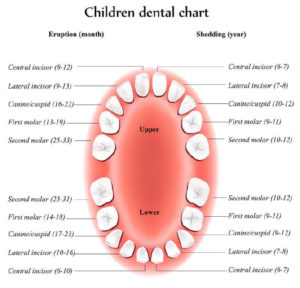Many parents worry that their child’s teeth are not falling out on time. At what age should the first baby tooth be lost? When should the last one fall out? Is there a predictable order?
The first baby teeth (also known as primary teeth) to come in are usually the lower central incisors around the age of six months. The last baby teeth to show up are the upper second molars, and they appear between 2 and a half to 3 years of age. There are normally 20 baby teeth by the time a child reaches age 3. These primary teeth then remain unchanged for about three years.
Not much happens to the baby teeth between 3 and 6 years of age. Between 6 and 8 years however, there is a flurry of activity as kids normally lose eight primary teeth in rapid succession. Between age 8 and age 10 there is another two-year pause that catches many parents by surprise since they have become accustomed to teeth being lost left and right. The last twelve primary teeth are then lost between ages 10 and 13. The following chart summarizes primary tooth loss:
Ages 3-6: Not much happens
Ages 6-8: First eight baby teeth lost
Ages 8-10: Not much happens
Ages 10-13: Last twelve baby teeth lost

Although there are always exceptions, there is a basic sequence for the loss of the baby teeth. In summary, here is the order in which baby teeth are normally lost:
Age 6: Lower and upper central incisors
Age 7: Lower and upper lateral incisors
Age 10: Lower canines and upper first molars
Age 11: Lower first molars
Age 12: Upper and lower second molars and upper canines
These are merely averages however. Some kids lose teeth faster than this. Others lose them slower. It is not unusual to see a 10-year-old with no baby teeth remaining, nor is it surprising to see a 14-year-old still hanging on to a few. The actual ages are not as important as the pattern.
If baby teeth are not lost in the right order, or if a tooth is lost and more than 3-6 months go by without a permanent replacement coming in, there may a problem. Some possibilities include missing teeth, crowding, problems with the tooth loss mechanism, or the underlying tooth is just crooked and it is not pushing out the one above it. These are all conditions that Dr. Manfred will look for during your child’s orthodontic evaluation.
